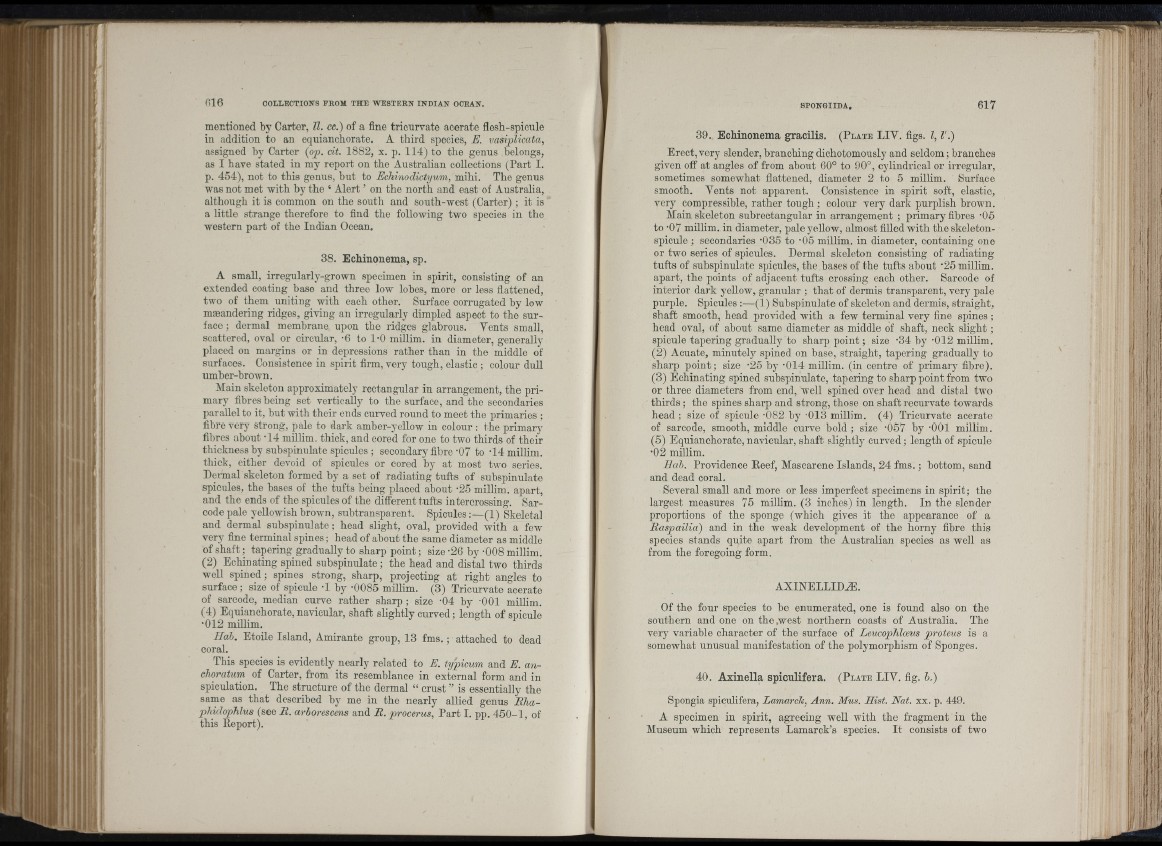
Ül
i ¡ii
i ” !
• 4
: lÍ i
moEtioned by Carter, ll. cc.) of a fine tricurvate acerate flesb-spicule
in addition to an equianchorate. A third species, E. vasiplicata,
assigned by Carter (op. cit. 1882, x. p. 114) to the genus belongs,
as I have stated in my report on tbe Australian collections (Part I.
p. 454), not to this genus, bnt to Echinodictyum, mihi. Tbe genus
was not met with by the ‘ Alert ’ on the north and east of Australia,
altbougb it is common on tbe south and south-west (Carter) ; it i s '
a little strange therefore to find tbe following two species in the
western part of tbe Indian Ocean.
38. Echinonema, sp.
A small, irregularly-grown specimen in spirit, consisting of an
extended coating base and threo low lobes, more or less flattened,
two of them uniting witb each other. Surface corrugated by low
maeandering ridges, giving an irregularly dimpled aspect to tbe surface
; dermal membrane upon the ridges glabrous. Yents small,
scattered, oval or circular, -6 to 1-0 millim. in diameter, generally
placed on margins or in depressions rather than in tbe middle of
surfaces. Consistence in spirit firm, very tough, elastic ; colour dull
umber-brown.
Main skeleton approximately rectangular in arrangement, the primary
fibres being set vertically to tbe surface, and the secondaries
parallel to it, but with tbeir ends curved round to meet the primaries ;
fibre very strong, pale to dark amber-yellow in colour : the primary
fibres about -14 millim. thick, and cored for one to two thirds of tbeir
thickness by subspinulate spicules ; secondary fibre -07 to -14 milbm.
thick, either devoid of spicules or cored by at most two series.
DermaTskeleton formed by a set of radiating tufts of subspinulate
spicules, the bases of tbe tufts being placed about -25 millim. apart,
and tbe ends of the spicules of the different tufts intercrossing. Sarcode
pale yellowish brown, subtransparent. Spicules :—(1) Skeletal
and dermal subspinulate; head slight, oval, provided with a few
very fine terminal spines; head of about tho same diameter as middle
of shaft; tapering gradually to sharp point; size -26 by -008 millim.
(2) Ecbinating spiued subspinulate; tbe bead and distal two thirds
well spined; spiues strong, sharp, projecting at right angles to
surface ; size of spicule -1 by -0085 millim. (3) Tricurvate acerate
of sarcode, median curve ratber sbarp ; size -04 by -001 millim.
(4) Equianchorate, navicular, shaft slightly curved; length of spicule
•012 milbm.
Hah. Etoile Island, Amirante group, 13 fm s.; attached to dead
coral.
This species is evidently nearly related to E. typicum and E. anchoratum
of Carter, from its resemblance in external form and in
spiculation. Tbe structure of the dermal “ crust ” is essentially the
same as th at described by me in tbe nearly allied genus Rhaphidophlus
(see R . arborescens and R . procerus, P a rt I. pp. 450-1, of
tbis Report).
39. Ecbinonema gracilis. ( P l a t e LIY. figs. Z, I'.)
Erect, very slender, branching dichotomously aud seldom ; branches
given off at angles of from about 60° to 90°, cylindrical or irregular,
sometimes somewhat flattened, diameter 2 to 5 milbm. Surface
smooth. Vents not apparent. Consistence in spirit soft, elastic,
very compressible, rather tough ; colour very dark purplish brown.
Main skeleton suhrectangular in arrangement ; primary fibres -05
to '07 milbm. in diameter, pale yellow, almost filled with the skeleton-
spicule ; secondaries ‘035 to -05 millim. in diameter, containing one
or two series of spicules. Dermal skeleton consisting of radiating
tufts of subspinulate spicules, the bases of the tufts about '25 milbm.
apart, the points of adjacent tufts crossing each other. Sarcode of
interior dark yellow, granular ; th at of dermis transparent, very pale
purple. Spicules :—(1) Subspinulate of skeleton and dermis, straight,
shaft smooth, head provided with a few terminal very fine spines ;
bead oval, of about same diameter as middle of sbaft, neck slight ;
spicule tapering gradually to sharp point ; size -34 by -012 milbm.
(2) Acuate, minutely spined on base, straight, tapering gradually to
sharp point; size -25 by -014 millim. (in centre of primary fibre).
(3) Echinating spined subspinulate, tapering to sbarp point from two
or three diameters from end, well spined over bead and distal two
thirds ; the spines sharp and strong, those on sbaft recúrvate towards
bead ; size of spicule -082 by '013 milbm. (4) Tricurvate acerate
of sarcode, smooth, middle curve bold ; size -057 by -001 millim.
(5) Equianchorate, navicular, sbaft slightly curved ; length of spicule
•02 millim.
Hah. Providence Reef, Mascarene Islands, 24 fms. ; bottom, sand
and dead coral.
Several small and more or less imperfect specimens in spirit; the
largest measures 75 milbm. (3 inches) in length. In tbe slender
proportions of the sponge (which gives it tbe appearance of a
Raspailia) and in the weak development of tbe horny fibre this
species stands quite apart from the Australian species as well as
from tbe foregoing form.
AXINELLIDÆ.
Of the four species to be enumerated, one is found also on the
southern and one on tbe .west northern coasts of Australia. Tbe
very variable character of the surface of Leucophloeus proteus is a
somewhat unusual manifestation of tbe polymorphism of Sponges.
40. Axinella spiculifera. ( P l a t e LIV. fig. h.)
Spongia spiculifera, Lamarck, Ann. Mus. Hist. Nat. xx. p. 449.
A specimen in spirit, agreeing well witb the fragment in tbe
Museum wbicb represents Lamarck’s species. I t consists of two
1 Í
.'11, ;l
I'